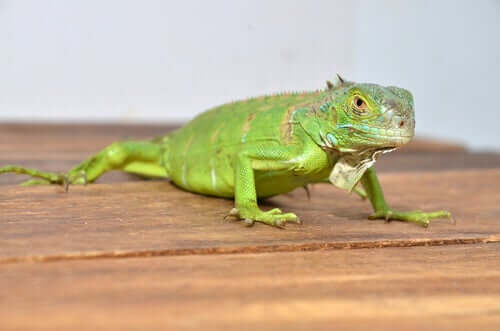Metabolic Bone Disease in Reptiles

Exotic animals can make complicated pets, not least because of their dietary requirements. In fact, mistakes with their diet are the most common cause of metabolic bone disease in reptiles.
Many of the diseases that reptiles can suffer from are easy to prevent if you know what their needs are.
Metabolic bone disease can occur in many species of reptile, such as snakes or monitor lizards. But the species that most commonly suffers this condition is the iguana. Therefore, understanding what an iguana needs for its basic care is vital for preventing the condition.
Causes of metabolic bone disease in reptiles
The disease is mainly caused by a lack of calcium, and this is normally as a result of their diet. However, it can also be caused by a lack of vitamin D as a result of poor care.
To be more specific, it’s related to an imbalance in the relationship between calcium and phosphorous. This means that a calcium deficiency may be due to excess phosphorous.

This means that calcium is extracted from the bones, making them weaker and even leading to deformities.
But it’s not just excess phosphorous that can cause a lack of calcium. Excess fat can also decrease calcium absorption, as can a lack of exposure to UVA rays as a result of a lack of vitamin D.
Symptoms of metabolic bone disease
This disease, which usually appears in young animals, can be noticed through inflammation of the jaw. This is the most obvious place that swelling occurs, but it actually affects the entire skeleton.
Swollen limbs, finger deformities, and spinal deviations are amongst the other symptoms, and they can lead to mobility problems and even bone fractures.
These deformities and fractures will become more evident and serious depending on the extent of their deficiency. If they’ve suffered for a long period of time, their problems will become very obvious, and they may even require the use of a prosthetic wheel to move around.
In these more serious cases, a simple change in diet is simply not enough. You’ll need to take your pet to the vet as soon as possible. Your reptile is likely to be in pain and will probably be refusing to eat.
This, in turn, can lead to them becoming very thin, which is a common symptom in chameleons, and it usually affects their long tongue. But beyond these symptoms, the vet will be able to confirm the presence of the disease using a simple X-ray.
In these more serious cases, a simple change in diet is simply not enough. You will need to take your pet to the vet as soon as possible.
Treatment and prevention
To prevent this condition, or if they are only suffering mild symptoms, the first step is to be stricter with the way you look after your pet.

Make sure to restructure your reptile’s diet and include natural sources of calcium. Using supplements is fine, but plants like dandelion can make a great addition to natural calcium.
In general, the ideal diet for any turtle, iguana or other reptile suffering from this disease is one containing twice as much calcium as phosphorous.
Beyond diet, it’s important to keep their habitat at the correct temperature for the species and ensure that they have daily exposure to UVA rays. Ideally, part of this should be natural sunlight.
More serious cases will require medications based on calcium supplements, and this should always be under the supervision of a vet. It goes without saying that without treatment, the animal will die.
Make sure to restructure your reptile’s diet and include natural sources of calcium. Using supplements is fine, but plants like dandelion can make a great addition to natural calcium.
This text is provided for informational purposes only and does not replace consultation with a professional. If in doubt, consult your specialist.